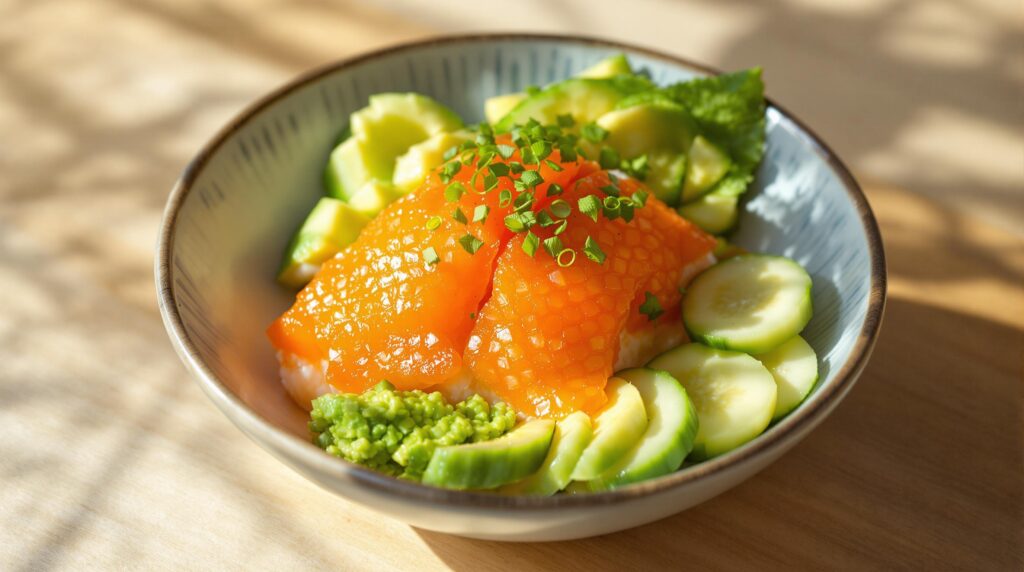Introduction to Tobiko
Tobiko, the roe of flying fish, is a culinary gem celebrated for its vibrant colors, crunchy texture, and subtle flavor. Often featured in Japanese cuisine, tobiko adds a visual and textural pop to sushi, sashimi, and various fusion dishes. Its versatility and aesthetic appeal have made it a favorite for chefs and food enthusiasts alike.
To discover more ways to incorporate this vibrant roe into your meals, explore Recipes4Hub’s collection of creative dishes. For fusion ideas, try pairing it with lemon butter garlic shrimp pasta, where its crunch and flavor can elevate the dish.
What Is Tobiko?
This vibrant, colorful roe comes from flying fish found in tropical and subtropical waters. Its bright orange hue and crunchy texture make it a popular garnish in Japanese cuisine. The roe is typically cured with salt and natural flavorings, enhancing its mildly sweet, salty taste and smoky undertone.
Types of Tobiko
- Natural Roe: Bright orange with a mildly smoky, salty flavor.
- Colored Variations:
- Black: Colored with squid ink, adding a briny depth.
- Red: Enhanced with beet juice for a subtle sweetness.
- Green: Infused with wasabi for a spicy kick.
- Yellow: Flavored with yuzu, delivering a citrusy tang.
These variations not only add visual appeal but also provide unique flavor profiles suited to different dishes. For a detailed breakdown of tobiko’s uses, explore The Japanese Bar’s guide.
Culinary Applications of Tobiko
Tobiko is an incredibly versatile ingredient that enhances a wide range of dishes, from traditional Japanese cuisine to modern fusion recipes.
Traditional Uses
- Sushi and Sashimi
- A common topping for sushi rolls like California rolls and Dragon rolls.
- Adds a crunchy contrast to sashimi platters.
- Appetizers
- Tobiko-topped crackers or cream cheese-stuffed cucumbers.
- Used as a garnish for seafood salads or deviled eggs.
- Rice and Noodle Dishes
- Mixed into rice bowls or soba noodles for added texture and umami.
Fusion Cuisine
- Pasta
- Incorporate tobiko into creamy pasta sauces for a burst of flavor and crunch.
- Omelets and Breakfast Dishes
- Sprinkle tobiko over fluffy omelets or scrambled eggs.
- Cocktail Garnishes
- A unique addition to martinis or seafood cocktails.
For a fusion pairing, try this dish alongside sun-dried tomato and feta stuffed French toast.
How Tobiko Is Harvested and Processed
Sourcing
Flying fish roe comes from warm tropical and subtropical waters, especially in regions like Japan, Taiwan, and Indonesia. Harvesters extract the eggs and preserve them immediately to maintain freshness and texture.
Processing
- Curing: The roe is cured with salt and natural flavorings like squid ink or wasabi.
- Flavor Enhancements: Additives such as beet juice or yuzu create unique flavors and vibrant colors.
- Quality Control: High-quality roe is bright, clean, and free from excess moisture, ensuring the best flavor and texture.
Cooking with Fish Roe at Home
Handling and Storage
- Refrigeration: Store in an airtight container and consume within 3–5 days after opening.
- Freezing: For long-term storage, freeze the roe in a sealed container; it can last up to three months.
Easy Recipes
- Flying Fish Roe Sushi Rolls
- Ingredients: Sushi rice, nori (seaweed), cucumber, avocado, and tobiko.
- Steps: Spread rice over nori, add fillings, roll tightly, and top with tobiko.
- Deviled Eggs with Flying Fish Roe
- Ingredients: Hard-boiled eggs, mayonnaise, mustard, and tobiko.
- Steps: Prepare the egg filling, pipe it back into the whites, and garnish with tobiko.
- Creamy Pasta with Flying Fish Roe
- Ingredients: Pasta, heavy cream, garlic, parmesan cheese, and tobiko.
- Steps: Prepare a creamy garlic sauce, mix with cooked pasta, and top with tobiko.
Sustainability and Ethical Concerns
Flying fish roe is typically harvested sustainably, but overfishing and habitat disruption can pose challenges. To ensure environmental responsibility:
- Choose roe from certified sustainable fisheries.
- Support suppliers that follow ethical harvesting practices.
Cultural Significance of Tobiko
In Japanese cuisine, this vibrant roe symbolizes abundance and prosperity, often used in festive dishes. Beyond Japan, it has become a staple in global fusion cuisine, admired for its ability to enhance flavors and textures.
Comparisons with Other Fish Roes
- Masago (Capelin Roe): Smaller and less crunchy than Fish Roe, with a milder flavor.
- Ikura (Salmon Roe): Larger, with a bold, salty taste and a burst-in-your-mouth texture.
FAQs About Tobiko
What does tobiko taste like?
It has a mildly sweet and salty flavor with a hint of smokiness and a crunchy texture.
Is tobiko raw?
Yes, Fish Roe is raw but cured for preservation.
Is it safe to eat tobiko during pregnancy?
If sourced from reputable suppliers and consumed in moderation, it is generally safe during pregnancy.
Is tobiko healthy?
Yes, it is rich in protein, omega-3 fatty acids, and vitamins, though it can be high in sodium.
Conclusion
Tobiko is more than just a garnish—it’s a versatile ingredient that enhances the visual appeal, flavor, and texture of countless dishes. From sushi and pasta to innovative fusion creations, Fish Roe offers endless possibilities for culinary exploration.
For more creative ideas and recipes, visit Recipes4Hub and discover how Fish Roe can elevate your cooking to the next level!



